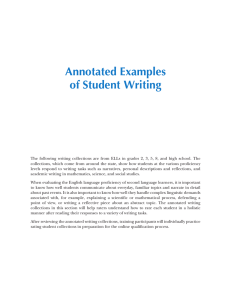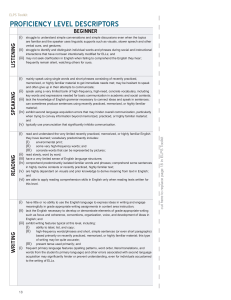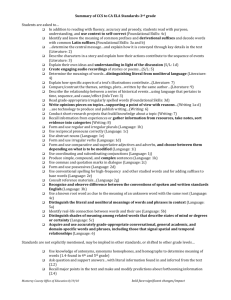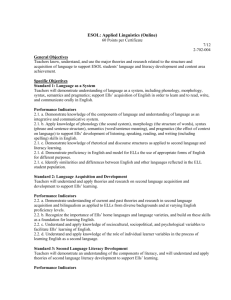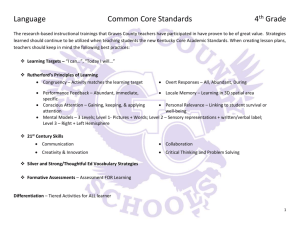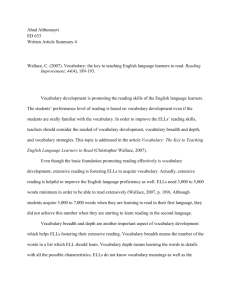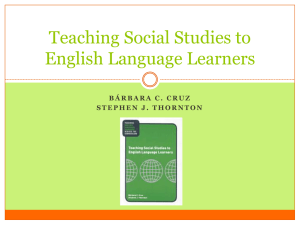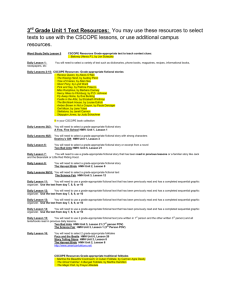Rater 2 - Sheldon ISD
advertisement
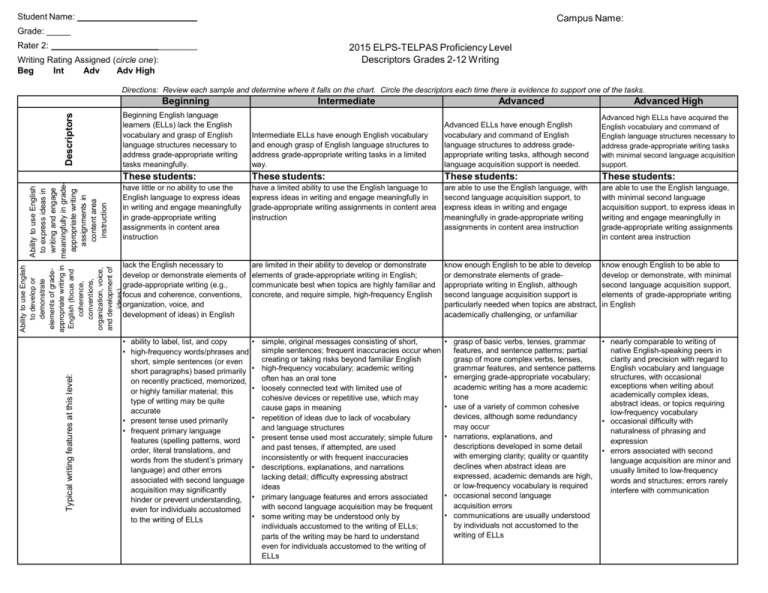
Student Name: _____ Campus Name: Grade: _____ Rater 2: ________ 2015 ELPS-TELPAS Proficiency Level Descriptors Grades 2-12 Writing Writing Rating Assigned (circle one): Beg Int Adv Adv High Directions: Review each sample and determine where it falls on the chart. Circle the descriptors each time there is evidence to support one of the tasks. Descriptors Beginning Beginning English language learners (ELLs) lack the English vocabulary and grasp of English language structures necessary to address grade-appropriate writing tasks meaningfully. Typical writing features at this level: Intermediate ELLs have enough English vocabulary and enough grasp of English language structures to address grade-appropriate writing tasks in a limited way. Advanced Advanced ELLs have enough English vocabulary and command of English language structures to address gradeappropriate writing tasks, although second language acquisition support is needed. Advanced High Advanced high ELLs have acquired the English vocabulary and command of English language structures necessary to address grade-appropriate writing tasks with minimal second language acquisition support. These students: These students: These students: have little or no ability to use the English language to express ideas in writing and engage meaningfully in grade-appropriate writing assignments in content area instruction have a limited ability to use the English language to express ideas in writing and engage meaningfully in grade-appropriate writing assignments in content area instruction are able to use the English language, with second language acquisition support, to express ideas in writing and engage meaningfully in grade-appropriate writing assignments in content area instruction are able to use the English language, with minimal second language acquisition support, to express ideas in writing and engage meaningfully in grade-appropriate writing assignments in content area instruction lack the English necessary to develop or demonstrate elements of grade-appropriate writing (e.g., focus and coherence, conventions, organization, voice, and development of ideas) in English are limited in their ability to develop or demonstrate elements of grade-appropriate writing in English; communicate best when topics are highly familiar and concrete, and require simple, high-frequency English know enough English to be able to develop or demonstrate elements of gradeappropriate writing in English, although second language acquisition support is particularly needed when topics are abstract, academically challenging, or unfamiliar know enough English to be able to develop or demonstrate, with minimal second language acquisition support, elements of grade-appropriate writing in English • ability to label, list, and copy • high-frequency words/phrases and short, simple sentences (or even short paragraphs) based primarily on recently practiced, memorized, or highly familiar material; this type of writing may be quite accurate • present tense used primarily • frequent primary language features (spelling patterns, word order, literal translations, and words from the student’s primary language) and other errors associated with second language acquisition may significantly hinder or prevent understanding, even for individuals accustomed to the writing of ELLs • simple, original messages consisting of short, simple sentences; frequent inaccuracies occur when creating or taking risks beyond familiar English • high-frequency vocabulary; academic writing often has an oral tone • loosely connected text with limited use of cohesive devices or repetitive use, which may cause gaps in meaning • repetition of ideas due to lack of vocabulary and language structures • present tense used most accurately; simple future and past tenses, if attempted, are used inconsistently or with frequent inaccuracies • descriptions, explanations, and narrations lacking detail; difficulty expressing abstract ideas • primary language features and errors associated with second language acquisition may be frequent • some writing may be understood only by individuals accustomed to the writing of ELLs; parts of the writing may be hard to understand even for individuals accustomed to the writing of ELLs • grasp of basic verbs, tenses, grammar • nearly comparable to writing of features, and sentence patterns; partial native English-speaking peers in grasp of more complex verbs, tenses, clarity and precision with regard to grammar features, and sentence patterns English vocabulary and language structures, with occasional • emerging grade-appropriate vocabulary; exceptions when writing about academic writing has a more academic academically complex ideas, tone abstract ideas, or topics requiring • use of a variety of common cohesive low-frequency vocabulary devices, although some redundancy • occasional difficulty with may occur naturalness of phrasing and • narrations, explanations, and expression descriptions developed in some detail • errors associated with second with emerging clarity; quality or quantity language acquisition are minor and declines when abstract ideas are usually limited to low-frequency expressed, academic demands are high, words and structures; errors rarely or low-frequency vocabulary is required interfere with communication • occasional second language acquisition errors • communications are usually understood by individuals not accustomed to the writing of ELLs Ability to use English to develop or Ability to use English demonstrate to express ideas in elements of gradewriting and engage appropriate writing in meaningfully in gradeEnglish (focus and appropriate writing coherence, assignments in conventions, content area organization, voice, instruction and development of ideas) These students: Intermediate

